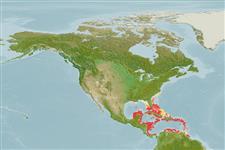Common names from other countries
Environment: milieu / climate zone / depth range / distribution range
Écologie
Récifal; profondeur 0 - 70 m (Ref. 847). Subtropical; 35°N - 8°N, 92°W - 58°W (Ref. 847)
Distribution
Pays | Zones FAO | Écosystèmes | Occurrences | Introductions
Western Atlantic: USA to Caribbean Sea.
Length at first maturity / Taille / Poids / Âge
Maturity: Lm ? range ? - ? cm
Description synthétique
Morphologie
Encrusting to submassive colonies. Deep, monocentric corallites with 2-3 centers. Centers are separated by collines of irregular height and which run in irregular directions. Long and short septocostae clearly alternate. Uniform tan or mottled yellow-brown, sometimes with green mouths in color.
Maximum depth from Ref. 83917. Zooxanthellate (Ref. 116012).
Life cycle and mating behavior
Maturité | Reproduction | Frai | Œufs | Fécondité | Larves
Hermaphroditic (Ref. 113712). Mature gametes are shed into the coelenteron and spawned through the mouth. Life cycle: The zygote develops into a planktonic planula larva. Metamorphosis begins with early morphogenesis of tentacles, septa and pharynx before larval settlement on the aboral end (Ref. 833).
Collin, R., M.C. Díaz, J. Norenburg, R.M. Rocha, J.A. Sánchez, M. Schulze, A. Schwartz and A. Valdés. 2005. (Ref. 415)
Statut dans la liste rouge de l'IUCN (Ref. 130435)
statut CITES (Ref. 108899)
Not Evaluated
Utilisations par l'homme
| FishSource |
Outils
Plus d'informations
Taille/ÂgeCroissanceLongueur-poidsLongueur-longueurMorphologieLarvesAbondance
Sources Internet
Estimates based on models
Preferred temperature
(Ref.
115969): 25.1 - 28.1, mean 27.1 (based on 164 cells).
Catégorie de prix
Unknown.
